Delphi - Retrieve email using Microsoft OAuth 2.0 + EWS/IMAP4/Graph API protocol from Office 365 account¶
You can retrieve email using traditional user/password authentication from Office 365 account by EWS, IMAP4 or Graph API Protocol.
However Microsoft will disable traditional user authentication in the future, switching to Microsoft OAuth (Modern Authentication) is strongly recommended now.
Sections:
- Installation
- Add reference
- Create your application in Azure Portal
- Register application
- Single tenant and multitenant in account type
- Assign API permission
- EWS API permission
- Authentication and redirect uri
- Client Id and client secrets
- Branding and verify publisher
- Client id and tenant
- Enable TLS Strong Encryption Algorithms in .NET 2.0 and .NET 4.0
- Use client id and client secret to request access token
- Access token expiration and refresh token
- Delphi - Retrieve email using Microsoft OAuth + Office 365 IMAP4 protocol
- Delphi - Retrieve email using Microsoft OAuth + Microsoft Graph API
- Delphi - Retrieve email using Microsoft OAuth + Office 365 EWS protocol
- TLS 1.2 protocol
- EA Oauth Service for Office 365
- Related links
Installation¶
Before you can use the following sample codes, you should download the EAGetMail Installer and install it on your machine at first. Full sample projects are included in this installer.
Add reference¶
To better demonstrate how to retrieve email and parse email, let’s create a Delphi Standard EXE project at first, then add a TButton on the Form, double-click this button. It is like this:
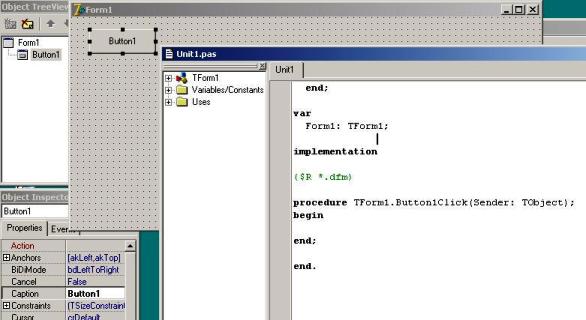
To use EAGetMail ActiveX Object in your Delphi project, the first step is “Add Unit file of EAGetMail to your project”. Please go to
C:\Program Files\EAGetMail\Include\delphi or
C:\Program Files (x86)\EAGetMail\Include\delphi folder,
find EAGetMailObjLib_TLB.pas, and then copy this file to your project folder.
// include EAGetMailObjLib_TLB unit to your Delphi Project
unit Unit1;
interface
uses
Windows, Messages, SysUtils, Variants, Classes, Graphics, Controls, Forms,
Dialogs, EAGetMailObjLib_TLB, StdCtrls;
Then you can start to use it in your Delphi Project.
You can also create EAGetMailObjLib_TLB.pas manually by Delphi like this:
Delphi 7 or eariler version
First of all, create a standard delphi project: select menu
Project->Import Type Library, checkedEAGetMail ActiveX Objectand clickCreate Unit. Then includeEAGetMailObjLib_TLBin your project.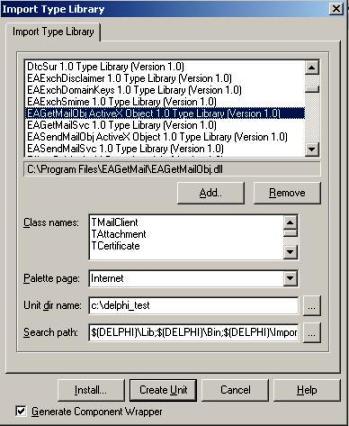
Delphi XE or later version
First of all, create a standard delphi project: select menu
Component->Import component...->Import a type library-> checkedEAGetMail ActiveX Object, haveGenerate Component Wrapperchecked and click “Create Unit”. Then includeEAGetMailObjLib_TLBin your project.
Create your application in Azure Portal¶
To use Microsoft/Office365/Live OAuth (Modern Authentication) in your application, you must create a application in Azure Portal.
- Sign in to the
Azure portalusing either a work or school account or a personal Microsoft account. - If your account gives you access to more than one tenant, select your account in the top right corner,
and set your portal session to the
Azure AD tenantthat you want.
Search Microsoft Entra ID (old name “Azure Active Directory”) and go to this service:
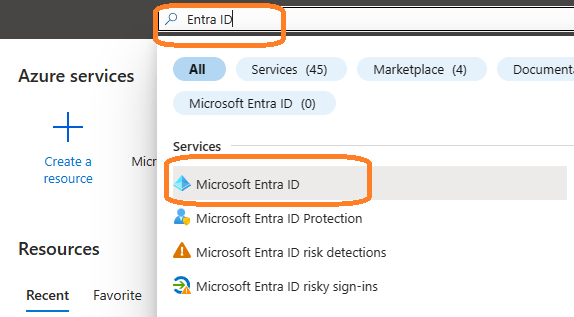
Register application¶
In the left-hand navigation pane, select the Microsoft Entra ID service, and then select App registrations -> New registration.
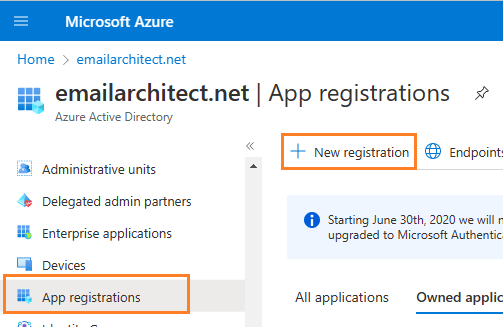
Input a name to to register the application:
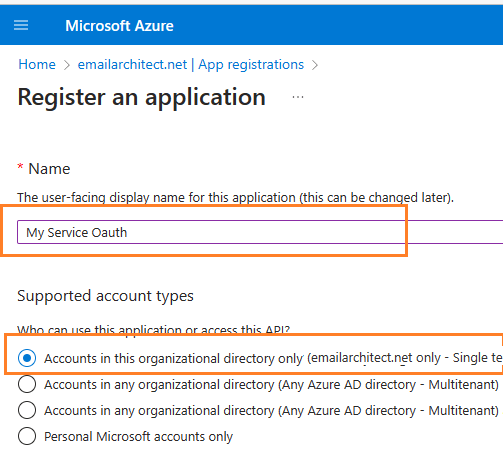
Single tenant and multitenant in account type¶
When the register an application page appears, enter a meaningful application name and select the account type.
Select which accounts you would like your application to support.
- If your application only supports the users in your directory or organization, please select
Single tenanttype; - If your application needs to support all users in Office 365 and Microsoft personal account (hotmail.com, outlook.com),
please select
Multitenanttype, and you must verify publisher.
Because we want to support all Office 365 and
LIVE SDK (hotmail, outlook personal account), so select
Accounts in any organizational directory and personal Microsoft accounts.
Important
If you don’t verify publisher for multitenant application, your application will not request access token successfully.
Assign API permission¶
Now you need to assign API permission to the application by clicking API Permission -> Add a permission.
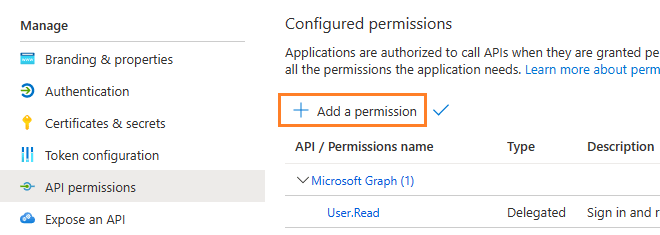
You don’t have to assign all the API permissions below to the application, just assign the API permission(s) you need.
| Protocol | Permission | Scope | |
| Graph API | Mail.Send, Mail.ReadWrite | https://graph.microsoft.com/Mail.Send, https://graph.microsoft.com/Mail.ReadWrite | |
| EWS | EWS.AccessAsUser.All | https://outlook.office.com/EWS.AccessAsUser.All | |
| SMTP | SMTP.Send | https://outlook.office365.com/SMTP.Send | |
| POP | POP.AccessAsUser.All | https://outlook.office365.com/POP.AccessAsUser.All | |
| IMAP | IMAP.AccessAsUser.All | https://outlook.office365.com/IMAP.AccessAsUser.All |
Now we need to add permission to the application:
- Click
API Permission-> Add a permission->Microsoft Graph->Delegated Permission->User.Read,email,offline_access,openid,profile,SMTP.Send,IMAP.AccessAsUser.All,POP.AccessAsUser.All,Mail.Send,Mail.ReadWrite.
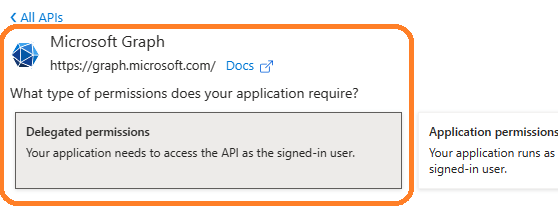
EWS API permission¶
With the above permissions, your application can support SMTP, POP and IMAP service. If your application needs to support EWS protocol either, add EWS permission like this:
- Click
API Permission-> Add a permission->APIs in my organization uses->Office 365 Exchange Online->Delegated Permission->Check EWS.AccessAsUser.All

Here is permissions list:
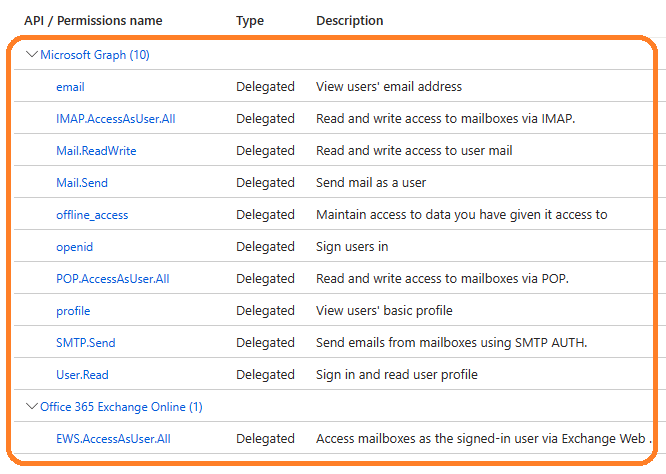
Authentication and redirect uri¶
Because the example code is based on desktop application, so add Redirect Uri like this:
Click
"Authentication"->Add a platform->Mobile and desktop applications->Redirect Uri, please check or add the following URI.https://login.microsoftonline.com/common/oauth2/nativeclient https://login.microsoftonline.com/common/oauth2/nativeclient http://127.0.0.1
Note
https://login.microsoftonline.com/common/oauth2/nativeclientis used for Live SDK,http://127.0.0.1is used for local Http Listener.
If your application needs to support Microsoft personal account, set both
"Live SDK Support"and"Treat application as a public client"to"Yes".
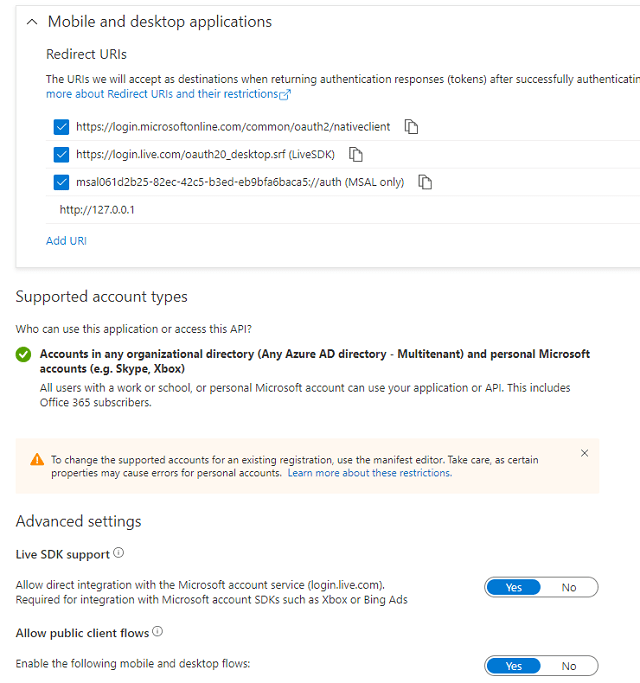
Client Id and client secrets¶
Now we need to create a client secret for the application,
click Certificates and secrets -> client secrets and add a new client secret.

After client secret is created, store the client secret value to somewhere.
Important
Please store client secret value by yourself, because it is hidden when you view it at next time.
Branding and verify publisher¶
Now we click Branding, you can edit your company logo, URL and application name. If your application supports
multitenant (access user in all Office 365 and Microsoft personal account), you must complete the publisher verification.
It is not difficult, you can have a look at publisher verification. After publisher verification is completed, your branding is like this:
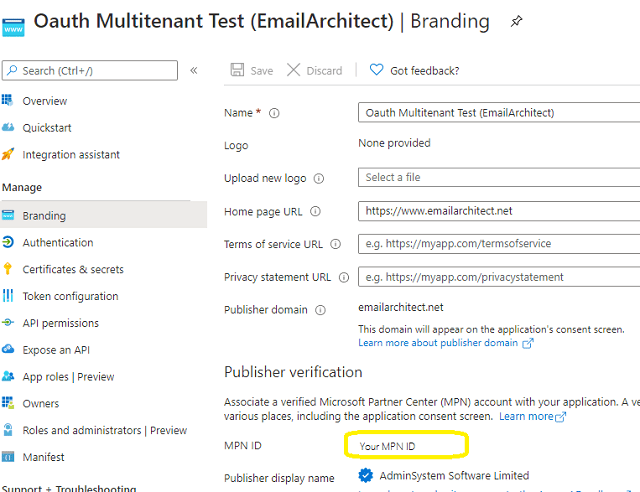
Important
You must complete the publisher verification for multitenant application, otherwise, your application will not request access token correctly.
Client id and tenant¶
Now you can click Overview to find your client id and tenant.

- If your application is
single tenant, use the tenant value intokenUriandauthUriinstead ofcommon. - If your application is
multitenant, usecommonas tenant.
Above client id and client secret support both "Office365 + SMTP/POP/IMAP/EWS" and
"Live (hotmail, outlook personal account) + SMTP/POP/IMAP",
Enable TLS Strong Encryption Algorithms in .NET 2.0 and .NET 4.0¶
Because HttpWebRequest is used to get access token from web service.
If you’re using legacy .NET framework (.NET 2.0 - .NET 3.5 and .NET 4.0 - 4.6.1),
you need to enable Strong Encryption Algorithms to request access token:
Put the following content to a file named NetStrongEncrypt.reg, right-click this file -> Merge -> Yes.
You can also download it from https://www.emailarchitect.net/webapp/download/NetStrongEncrypt.zip.
Windows Registry Editor Version 5.00
[HKEY_LOCAL_MACHINE\SOFTWARE\Microsoft\.NETFramework\v2.0.50727]
"SystemDefaultTlsVersions"=dword:00000001
"SchUseStrongCrypto"=dword:00000001
[HKEY_LOCAL_MACHINE\SOFTWARE\Wow6432Node\Microsoft\.NETFramework\v2.0.50727]
"SystemDefaultTlsVersions"=dword:00000001
"SchUseStrongCrypto"=dword:00000001
[HKEY_LOCAL_MACHINE\SOFTWARE\Microsoft\.NETFramework\v4.0.30319]
"SystemDefaultTlsVersions"=dword:00000001
"SchUseStrongCrypto"=dword:00000001
[HKEY_LOCAL_MACHINE\SOFTWARE\Wow6432Node\Microsoft\.NETFramework\v4.0.30319]
"SystemDefaultTlsVersions"=dword:00000001
"SchUseStrongCrypto"=dword:00000001
Use client id and client secret to request access token¶
You can use client id and client secret to get the user email address and access token like this:
- Your application uses a web browser/browser control to open Oauth Url;
- User inputs user and password in web authentication page, and then the Oauth server returns access token back to your application;
- Your application uses access token to access resource on the server.
- You can find full example codes in
EAGetMail Installation Path\Samples_{Programming language/Developer Tool}project.
Access token expiration and refresh token¶
You don’t have to open browser to request access token every time. By default,
access token expiration time is 3600 seconds, you can use the access token repeatedly before it is expired.
After it is expired, you can use refresh token to refresh access token directly without opening browser.
You can find full sample project in EAGetMail installation path to learn how to refresh token.
Important
You should create your client id and client secret, do not use the client id from example codes in production environment,
it is used for test purpose. If you got "This app isn't verified" information, please click "Advanced" -> Go to ... for test.
Delphi - Retrieve email using Microsoft OAuth + Office 365 IMAP4 protocol¶
Here is a console application which demonstrates how to use Microsoft OAuth to do user authentication and retrieve email using IMAP4 protocol.
Note
This sample cannot handle the event of Web Browser is closed by user manually before authentication is completed.
You can refer to the better sample project which uses Web Browser Control in EAGetMail installation path.
program Project1;
{$APPTYPE CONSOLE}
uses
Windows, Messages, SysUtils, Variants, Classes, Graphics, ActiveX, MSXML2_TLB, EAGetMailObjLib_TLB;
const
MailServerPop3 = 0;
MailServerImap4 = 1;
MailServerEWS = 2;
MailServerDAV = 3;
MailServerMsGraph = 4;
// Auth type
MailServerAuthLogin = 0;
MailServerAuthCRAM5 = 1;
MailServerAuthNTLM = 2;
MailServerAuthXOAUTH2 = 3;
CRYPT_MACHINE_KEYSET = 32;
CRYPT_USER_KEYSET = 4096;
CERT_SYSTEM_STORE_CURRENT_USER = 65536;
CERT_SYSTEM_STORE_LOCAL_MACHINE = 131072;
// GetMailInfosParam Flags
GetMailInfos_All = 1;
GetMailInfos_NewOnly = 2;
GetMailInfos_ReadOnly = 4;
GetMailInfos_SeqRange = 8;
GetMailInfos_UIDRange = 16;
GetMailInfos_PR_ENTRYID = 32;
GetMailInfos_DateRange = 64;
GetMailInfos_OrderByDateTime = 128;
// client configuration
// You should create your client id and client secret,
// do not use the following client id in production environment, it is used for test purpose only.
clientID = 'eccbabb2-3377-4265-85c1-ea2fb515f075';
clientSecret = 'QaR_RR:-5WqTY[nni9pdBr9xVybqrAu4';
// use IMAP scope
scope = 'https://outlook.office.com/IMAP.AccessAsUser.All%20email%20openid';
authUri = 'https://login.microsoftonline.com/common/oauth2/v2.0/authorize';
tokenUri = 'https://login.microsoftonline.com/common/oauth2/v2.0/token';
// if your application is single tenant, please use tenant id instead of common in authUri and tokenUri
// for example, your tenant is 669595d0-a4d7-47c5-8040-cf9970400e48, then
// authUri = "https://login.microsoftonline.com/669595d0-a4d7-47c5-8040-cf9970400e48/oauth2/v2.0/authorize";
// tokenUri = "https://login.microsoftonline.com/669595d0-a4d7-47c5-8040-cf9970400e48/oauth2/v2.0/token";
function GetConsoleWindow: HWND; stdcall;
external kernel32 name 'GetConsoleWindow';
procedure RetrieveEmailWithXOAUTH2(email: string; accesstoken: string);
var
oServer: TMailServer;
oClient: TMailClient;
oTools: TTools;
oMail: IMail;
infos: IMailInfoCollection;
oInfo: IMailInfo;
localInbox, fileName: WideString;
i: Integer;
begin
try
// set current thread code page to system default code page.
SetThreadLocale(GetSystemDefaultLCID());
oTools := TTools.Create(nil);
// Create a folder named "inbox" under
// current directory to store the email files
localInbox := GetCurrentDir() + '\inbox';
oTools.CreateFolder(localInbox);
oServer := TMailServer.Create(nil);
// Office 365 Server
oServer.Server := 'outlook.office365.com';
// Use OAUTH 2.0
oServer.AuthType := MailServerAuthXOAUTH2;
oServer.User := email;
// Use access token as password
oServer.Password := accesstoken;
// Use IMAP Protocol
oServer.Protocol := MailServerImap4;
// Enable SSL Connection
oServer.SSLConnection := true;
// Set IMAP SSL Port
oServer.Port := 993;
oClient := TMailClient.Create(nil);
oClient.LicenseCode := 'TryIt';
writeln('Connecting ' + oServer.Server + ' ...');
oClient.Connect1(oServer.DefaultInterface);
writeln('Connected!');
// Get new email only, if you want to get all emails, please remove this line
oClient.GetMailInfosParam.GetMailInfosOptions := GetMailInfos_NewOnly;
infos := oClient.GetMailInfoList();
writeln(Format('Total %d email(s)', [infos.Count]));
for i := 0 to infos.Count - 1 do
begin
oInfo := infos.Item[i];
writeln(Format('Index: %d; Size: %d; UIDL: ' + oInfo.UIDL,
[oInfo.Index, oInfo.Size]));
// Generate a random file name by current local datetime,
// You can use your method to generate the filename if you do not like it
fileName := localInbox + '\' + oTools.GenFileName(i) + '.eml';
// Receive email from IMAP server
oMail := oClient.GetMail(oInfo);
writeln('From: ' + oMail.From.Address + #13#10 +
'Subject: ' + oMail.Subject);
// Save email to local disk
oMail.SaveAs(fileName, true);
// Mark email as read to prevent retrieving this email again.
oClient.MarkAsRead(oInfo, true);
// If you want to delete current email, please use Delete method instead of MarkAsRead
// oClient.Delete(oInfo);
end;
// Quit and expunge emails marked as deleted from IMAP server
oClient.Quit;
except
on ep:Exception do
writeln('Error: ' + ep.Message);
end;
end;
// path?parameter1=value1¶meter2=value2#anchor;
function ParseParameter(URL: string; ParameterName: string):string;
var
query, parameter, code: string;
i, mypos, parameterNameLength: integer;
list: TStrings;
begin
result := '';
parameterNameLength := Length(ParameterName);
query := URL;
mypos := pos('?', query);
if(mypos > 0) then
query := Copy(query, mypos + 1, length(query) - mypos);
list := TStringList.Create;
ExtractStrings(['&'], [], PChar(query), list);
for i:= 0 to list.Count - 1 do
begin
parameter := list[i];
if (length(parameter) > parameterNameLength) and
(LowerCase(Copy(parameter, 1, parameterNameLength)) = ParameterName) then
begin
code := Copy(parameter, parameterNameLength + 1, length(parameter) - parameterNameLength);
mypos := pos('#', code);
if(mypos > 0) then
code := Copy(code, 1, mypos - 1);
result := code;
exit;
end
end;
end;
function RequestAccessToken(code: string; codeVerifier: string; redirectUri: string): string;
var
httpRequest: TServerXMLHTTP60;
tokenRequestBody: OleVariant;
status: integer;
begin
writeln('Exchanging code for tokens...');
result := '';
try
httpRequest := TServerXMLHTTP60.Create(nil);
if (httpRequest = nil) then
begin
writeln('Failed to create XML HTTP Object, please make sure you install MSXML 3.0 on your machine.');
exit;
end;
tokenRequestBody := 'code=';
tokenRequestBody := tokenRequestBody + code;
tokenRequestBody := tokenRequestBody + '&redirect_uri=';
tokenRequestBody := tokenRequestBody + redirectUri;
tokenRequestBody := tokenRequestBody + '&client_id=';
tokenRequestBody := tokenRequestBody + clientID;
tokenRequestBody := tokenRequestBody + '&grant_type=authorization_code';
// append code_verifier for OAUTH PKCE.
tokenRequestBody := tokenRequestBody + '&code_verifier=';
tokenRequestBody := tokenRequestBody + codeVerifier;
httpRequest.setOption(2, 13056);
httpRequest.open('POST', tokenUri, true);
httpRequest.setRequestHeader('Content-Type', 'application/x-www-form-urlencoded');
httpRequest.send(tokenRequestBody);
while( httpRequest.readyState <> 4 ) do
httpRequest.waitForResponse(1);
status := httpRequest.status;
result := httpRequest.responseText;
if (status < 200) or (status >= 300) then
writeln('Failed to get access token from server: ' + httpRequest.responseText);
except
writeln('Server response timeout (access token) or exception.');
exit;
end;
end;
procedure DoOauthAndRetrieveEmail();
var
httpListener: THttpListener;
browserUi: TBrowserUi;
parser: TOAuthResponseParser;
szUri, requestUri: string;
authorizationRequest: string;
challenger: TOAuthCodeChallenge;
codeChallenge, codeVerifier, challengeMethod: string;
error, code: string;
responseText: string;
user, accessToken: string;
begin
httpListener := THttpListener.Create(nil);
// Creates a redirect URI using an available port on the loopback address.
if (not httpListener.Create1('127.0.0.1', 0)) then
begin
writeln('Failed to listen on ' + httpListener.GetLastError());
exit;
end;
szUri := Format('http://127.0.0.1:%d', [httpListener.ListenPort]);
writeln('listen on ' + szUri + ' ...');
// generate code challenge for PKCE, it is optional but recommended.
challenger := TOAuthCodeChallenge.Create(nil);
codeVerifier := challenger.Verifier;
codeChallenge := challenger.Challenge;
challengeMethod := challenger.ChallengeMethod;
// Creates the OAuth 2.0 authorization request.
authorizationRequest := authUri;
authorizationRequest := authorizationRequest + '?response_type=code&scope=';
authorizationRequest := authorizationRequest + scope;
authorizationRequest := authorizationRequest + '&redirect_uri=';
authorizationRequest := authorizationRequest + szUri;
authorizationRequest := authorizationRequest + '&client_id=';
authorizationRequest := authorizationRequest + clientID;
authorizationRequest := authorizationRequest + '&prompt=login';
// append code_challenge and code_challenge_method for OAUTH PKCE.
authorizationRequest := authorizationRequest + '&code_challenge=';
authorizationRequest := authorizationRequest + codeChallenge;
authorizationRequest := authorizationRequest + '&code_challenge_method=';
authorizationRequest := authorizationRequest + challengeMethod;
writeln('open ' + authorizationRequest + ' ...');
// Opens request in the browser.
browserUi := TBrowserUi.Create(nil);
browserUi.OpenUrl(authorizationRequest);
// Waits for the OAuth authorization response.
if not (httpListener.GetRequestUrl(-1)) then
begin
writeln('Failed to get authorization response ' + httpListener.GetLastError());
exit;
end;
// Brings the Console to Focus.
SetForegroundWindow(GetConsoleWindow());
// Send response and stop http listener.
httpListener.SendResponse('200',
'text/html; charset=utf-8',
'<html><head></head><body>Please return to the app and close current window.</body></html>');
httpListener.Close();
requestUri := httpListener.RequestUrl;
writeln('RequestUri: ' + requestUri);
// Checks for errors.
error := ParseParameter(requestUri, 'error=');
if (error <> '') then
begin
writeln('OAuth authorization error: ' + error);
exit;
end;
// Check authorization code
code := ParseParameter(requestUri, 'code=');
if (code = '') then
begin
writeln('Malformed authorization response: ' + requestUri);
exit;
end;
writeln;
writeln('Authorization code: ' + code);
responseText := RequestAccessToken(code, codeVerifier, szUri);
writeln(responseText);
parser := TOAuthResponseParser.Create(nil);
parser.Load(responseText);
user := parser.EmailInIdToken;
accessToken := parser.AccessToken;
if (accessToken = '') then
begin
writeln('Failed to request access token, return!');
exit;
end;
writeln('User: ' + user);
writeln('AccessToken:' + accessToken);
RetrieveEmailWithXOAUTH2(user, accessToken);
end;
begin
CoInitialize(nil);
writeln('+------------------------------------------------------------------+');
writeln(' Sign in with MS OAuth');
writeln(' If you got "This app is not verified" information in Web Browser, ');
writeln(' click "Advanced" -> Go to ... to continue test.');
writeln('+------------------------------------------------------------------+');
writeln('');
writeln('Press ENTER key to sign in...');
readln;
DoOauthAndRetrieveEmail();
writeln('Press ENTER key to quit...');
readln;
end.
Delphi - Retrieve email using Microsoft OAuth + Microsoft Graph API¶
Here is a console application which demonstrates how to use Microsoft OAuth to do user authentication and retrieve email using Microsoft Graph API protocol.
Note
This sample cannot handle the event of Web Browser is closed by user manually before authentication is completed.
You can refer to the better sample project which uses Web Browser Control in EAGetMail installation path.
program Project1;
{$APPTYPE CONSOLE}
uses
Windows, Messages, SysUtils, Variants, Classes, Graphics, ActiveX, MSXML2_TLB, EAGetMailObjLib_TLB;
const
MailServerPop3 = 0;
MailServerImap4 = 1;
MailServerEWS = 2;
MailServerDAV = 3;
MailServerMsGraph = 4;
// Auth type
MailServerAuthLogin = 0;
MailServerAuthCRAM5 = 1;
MailServerAuthNTLM = 2;
MailServerAuthXOAUTH2 = 3;
CRYPT_MACHINE_KEYSET = 32;
CRYPT_USER_KEYSET = 4096;
CERT_SYSTEM_STORE_CURRENT_USER = 65536;
CERT_SYSTEM_STORE_LOCAL_MACHINE = 131072;
// GetMailInfosParam Flags
GetMailInfos_All = 1;
GetMailInfos_NewOnly = 2;
GetMailInfos_ReadOnly = 4;
GetMailInfos_SeqRange = 8;
GetMailInfos_UIDRange = 16;
GetMailInfos_PR_ENTRYID = 32;
GetMailInfos_DateRange = 64;
GetMailInfos_OrderByDateTime = 128;
// client configuration
// You should create your client id and client secret,
// do not use the following client id in production environment, it is used for test purpose only.
clientID = 'eccbabb2-3377-4265-85c1-ea2fb515f075';
clientSecret = 'QaR_RR:-5WqTY[nni9pdBr9xVybqrAu4';
// use Graph API scope
scope = 'Mail.Send%20Mail.ReadWrite%20offline_access%20email%20openid';
authUri = 'https://login.microsoftonline.com/common/oauth2/v2.0/authorize';
tokenUri = 'https://login.microsoftonline.com/common/oauth2/v2.0/token';
// if your application is single tenant, please use tenant id instead of common in authUri and tokenUri
// for example, your tenant is 669595d0-a4d7-47c5-8040-cf9970400e48, then
// authUri = "https://login.microsoftonline.com/669595d0-a4d7-47c5-8040-cf9970400e48/oauth2/v2.0/authorize";
// tokenUri = "https://login.microsoftonline.com/669595d0-a4d7-47c5-8040-cf9970400e48/oauth2/v2.0/token";
function GetConsoleWindow: HWND; stdcall;
external kernel32 name 'GetConsoleWindow';
procedure RetrieveEmailWithXOAUTH2(email: string; accesstoken: string);
var
oServer: TMailServer;
oClient: TMailClient;
oTools: TTools;
oMail: IMail;
infos: IMailInfoCollection;
oInfo: IMailInfo;
localInbox, fileName: WideString;
i: Integer;
begin
try
// set current thread code page to system default code page.
SetThreadLocale(GetSystemDefaultLCID());
oTools := TTools.Create(nil);
// Create a folder named "inbox" under
// current directory to store the email files
localInbox := GetCurrentDir() + '\inbox';
oTools.CreateFolder(localInbox);
oServer := TMailServer.Create(nil);
// Office 365 Graph API Server
oServer.Server := 'graph.microsoft.com';
// Use OAUTH 2.0
oServer.AuthType := MailServerAuthXOAUTH2;
oServer.User := email;
// Use access token as password
oServer.Password := accesstoken;
// Use Graph API Protocol
oServer.Protocol := MailServerMsGraph;
// Enable SSL Connection
oServer.SSLConnection := true;
oClient := TMailClient.Create(nil);
oClient.LicenseCode := 'TryIt';
writeln('Connecting ' + oServer.Server + ' ...');
oClient.Connect1(oServer.DefaultInterface);
writeln('Connected!');
// Get new email only, if you want to get all emails, please remove this line
oClient.GetMailInfosParam.GetMailInfosOptions := GetMailInfos_NewOnly;
infos := oClient.GetMailInfoList();
writeln(Format('Total %d email(s)', [infos.Count]));
for i := 0 to infos.Count - 1 do
begin
oInfo := infos.Item[i];
writeln(Format('Index: %d; Size: %d; UIDL: ' + oInfo.UIDL,
[oInfo.Index, oInfo.Size]));
// Generate a random file name by current local datetime,
// You can use your method to generate the filename if you do not like it
fileName := localInbox + '\' + oTools.GenFileName(i) + '.eml';
// Receive email from IMAP server
oMail := oClient.GetMail(oInfo);
writeln('From: ' + oMail.From.Address + #13#10 +
'Subject: ' + oMail.Subject);
// Save email to local disk
oMail.SaveAs(fileName, true);
// Mark email as read to prevent retrieving this email again.
oClient.MarkAsRead(oInfo, true);
// If you want to delete current email, please use Delete method instead of MarkAsRead
// oClient.Delete(oInfo);
end;
oClient.Quit;
except
on ep:Exception do
writeln('Error: ' + ep.Message);
end;
end;
// path?parameter1=value1¶meter2=value2#anchor;
function ParseParameter(URL: string; ParameterName: string):string;
var
query, parameter, code: string;
i, mypos, parameterNameLength: integer;
list: TStrings;
begin
result := '';
parameterNameLength := Length(ParameterName);
query := URL;
mypos := pos('?', query);
if(mypos > 0) then
query := Copy(query, mypos + 1, length(query) - mypos);
list := TStringList.Create;
ExtractStrings(['&'], [], PChar(query), list);
for i:= 0 to list.Count - 1 do
begin
parameter := list[i];
if (length(parameter) > parameterNameLength) and
(LowerCase(Copy(parameter, 1, parameterNameLength)) = ParameterName) then
begin
code := Copy(parameter, parameterNameLength + 1, length(parameter) - parameterNameLength);
mypos := pos('#', code);
if(mypos > 0) then
code := Copy(code, 1, mypos - 1);
result := code;
exit;
end
end;
end;
function RequestAccessToken(code: string; codeVerifier: string; redirectUri: string): string;
var
httpRequest: TServerXMLHTTP60;
tokenRequestBody: OleVariant;
status: integer;
begin
writeln('Exchanging code for tokens...');
result := '';
try
httpRequest := TServerXMLHTTP60.Create(nil);
if (httpRequest = nil) then
begin
writeln('Failed to create XML HTTP Object, please make sure you install MSXML 3.0 on your machine.');
exit;
end;
tokenRequestBody := 'code=';
tokenRequestBody := tokenRequestBody + code;
tokenRequestBody := tokenRequestBody + '&redirect_uri=';
tokenRequestBody := tokenRequestBody + redirectUri;
tokenRequestBody := tokenRequestBody + '&client_id=';
tokenRequestBody := tokenRequestBody + clientID;
tokenRequestBody := tokenRequestBody + '&grant_type=authorization_code';
// append code_verifier for OAUTH PKCE.
tokenRequestBody := tokenRequestBody + '&code_verifier=';
tokenRequestBody := tokenRequestBody + codeVerifier;
httpRequest.setOption(2, 13056);
httpRequest.open('POST', tokenUri, true);
httpRequest.setRequestHeader('Content-Type', 'application/x-www-form-urlencoded');
httpRequest.send(tokenRequestBody);
while( httpRequest.readyState <> 4 ) do
httpRequest.waitForResponse(1);
status := httpRequest.status;
result := httpRequest.responseText;
if (status < 200) or (status >= 300) then
writeln('Failed to get access token from server: ' + httpRequest.responseText);
except
writeln('Server response timeout (access token) or exception.');
exit;
end;
end;
procedure DoOauthAndRetrieveEmail();
var
httpListener: THttpListener;
browserUi: TBrowserUi;
parser: TOAuthResponseParser;
szUri, requestUri: string;
authorizationRequest: string;
challenger: TOAuthCodeChallenge;
codeChallenge, codeVerifier, challengeMethod: string;
error, code: string;
responseText: string;
user, accessToken: string;
begin
httpListener := THttpListener.Create(nil);
// Creates a redirect URI using an available port on the loopback address.
if (not httpListener.Create1('127.0.0.1', 0)) then
begin
writeln('Failed to listen on ' + httpListener.GetLastError());
exit;
end;
szUri := Format('http://127.0.0.1:%d', [httpListener.ListenPort]);
writeln('listen on ' + szUri + ' ...');
// generate code challenge for PKCE, it is optional but recommended.
challenger := TOAuthCodeChallenge.Create(nil);
codeVerifier := challenger.Verifier;
codeChallenge := challenger.Challenge;
challengeMethod := challenger.ChallengeMethod;
// Creates the OAuth 2.0 authorization request.
authorizationRequest := authUri;
authorizationRequest := authorizationRequest + '?response_type=code&scope=';
authorizationRequest := authorizationRequest + scope;
authorizationRequest := authorizationRequest + '&redirect_uri=';
authorizationRequest := authorizationRequest + szUri;
authorizationRequest := authorizationRequest + '&client_id=';
authorizationRequest := authorizationRequest + clientID;
authorizationRequest := authorizationRequest + '&prompt=login';
// append code_challenge and code_challenge_method for OAUTH PKCE.
authorizationRequest := authorizationRequest + '&code_challenge=';
authorizationRequest := authorizationRequest + codeChallenge;
authorizationRequest := authorizationRequest + '&code_challenge_method=';
authorizationRequest := authorizationRequest + challengeMethod;
writeln('open ' + authorizationRequest + ' ...');
// Opens request in the browser.
browserUi := TBrowserUi.Create(nil);
browserUi.OpenUrl(authorizationRequest);
// Waits for the OAuth authorization response.
if not (httpListener.GetRequestUrl(-1)) then
begin
writeln('Failed to get authorization response ' + httpListener.GetLastError());
exit;
end;
// Brings the Console to Focus.
SetForegroundWindow(GetConsoleWindow());
// Send response and stop http listener.
httpListener.SendResponse('200',
'text/html; charset=utf-8',
'<html><head></head><body>Please return to the app and close current window.</body></html>');
httpListener.Close();
requestUri := httpListener.RequestUrl;
writeln('RequestUri: ' + requestUri);
// Checks for errors.
error := ParseParameter(requestUri, 'error=');
if (error <> '') then
begin
writeln('OAuth authorization error: ' + error);
exit;
end;
// Check authorization code
code := ParseParameter(requestUri, 'code=');
if (code = '') then
begin
writeln('Malformed authorization response: ' + requestUri);
exit;
end;
writeln;
writeln('Authorization code: ' + code);
responseText := RequestAccessToken(code, codeVerifier, szUri);
writeln(responseText);
parser := TOAuthResponseParser.Create(nil);
parser.Load(responseText);
user := parser.EmailInIdToken;
accessToken := parser.AccessToken;
if (accessToken = '') then
begin
writeln('Failed to request access token, return!');
exit;
end;
writeln('User: ' + user);
writeln('AccessToken:' + accessToken);
RetrieveEmailWithXOAUTH2(user, accessToken);
end;
begin
CoInitialize(nil);
writeln('+------------------------------------------------------------------+');
writeln(' Sign in with MS OAuth');
writeln(' If you got "This app is not verified" information in Web Browser, ');
writeln(' click "Advanced" -> Go to ... to continue test.');
writeln('+------------------------------------------------------------------+');
writeln('');
writeln('Press ENTER key to sign in...');
readln;
DoOauthAndRetrieveEmail();
writeln('Press ENTER key to quit...');
readln;
end.
Delphi - Retrieve email using Microsoft OAuth + Office 365 EWS protocol¶
Here is a console application which demonstrates how to use Microsoft OAuth to do user authentication and retrieve email using EWS protocol.
Note
This sample cannot handle the event of Web Browser is closed by user manually before authentication is completed.
You can refer to the better sample project which uses Web Browser Control in EAGetMail installation path.
program Project1;
{$APPTYPE CONSOLE}
uses
Windows, Messages, SysUtils, Variants, Classes, Graphics, ActiveX, MSXML2_TLB, EAGetMailObjLib_TLB;
const
MailServerPop3 = 0;
MailServerImap4 = 1;
MailServerEWS = 2;
MailServerDAV = 3;
MailServerMsGraph = 4;
// Auth type
MailServerAuthLogin = 0;
MailServerAuthCRAM5 = 1;
MailServerAuthNTLM = 2;
MailServerAuthXOAUTH2 = 3;
CRYPT_MACHINE_KEYSET = 32;
CRYPT_USER_KEYSET = 4096;
CERT_SYSTEM_STORE_CURRENT_USER = 65536;
CERT_SYSTEM_STORE_LOCAL_MACHINE = 131072;
// GetMailInfosParam Flags
GetMailInfos_All = 1;
GetMailInfos_NewOnly = 2;
GetMailInfos_ReadOnly = 4;
GetMailInfos_SeqRange = 8;
GetMailInfos_UIDRange = 16;
GetMailInfos_PR_ENTRYID = 32;
GetMailInfos_DateRange = 64;
GetMailInfos_OrderByDateTime = 128;
// client configuration
// You should create your client id and client secret,
// do not use the following client id in production environment, it is used for test purpose only.
clientID = 'eccbabb2-3377-4265-85c1-ea2fb515f075';
clientSecret = 'QaR_RR:-5WqTY[nni9pdBr9xVybqrAu4';
// use EWS scope
scope = 'https://outlook.office.com/EWS.AccessAsUser.All%20email%20openid';
authUri = 'https://login.microsoftonline.com/common/oauth2/v2.0/authorize';
tokenUri = 'https://login.microsoftonline.com/common/oauth2/v2.0/token';
// if your application is single tenant, please use tenant id instead of common in authUri and tokenUri
// for example, your tenant is 669595d0-a4d7-47c5-8040-cf9970400e48, then
// authUri = "https://login.microsoftonline.com/669595d0-a4d7-47c5-8040-cf9970400e48/oauth2/v2.0/authorize";
// tokenUri = "https://login.microsoftonline.com/669595d0-a4d7-47c5-8040-cf9970400e48/oauth2/v2.0/token";
function GetConsoleWindow: HWND; stdcall;
external kernel32 name 'GetConsoleWindow';
procedure RetrieveEmailWithXOAUTH2(email: string; accesstoken: string);
var
oServer: TMailServer;
oClient: TMailClient;
oTools: TTools;
oMail: IMail;
infos: IMailInfoCollection;
oInfo: IMailInfo;
localInbox, fileName: WideString;
i: Integer;
begin
try
// set current thread code page to system default code page.
SetThreadLocale(GetSystemDefaultLCID());
oTools := TTools.Create(nil);
// Create a folder named "inbox" under
// current directory to store the email files
localInbox := GetCurrentDir() + '\inbox';
oTools.CreateFolder(localInbox);
oServer := TMailServer.Create(nil);
// Office 365 Server
oServer.Server := 'outlook.office365.com';
// Use OAUTH 2.0
oServer.AuthType := MailServerAuthXOAUTH2;
oServer.User := email;
// Use access token as password
oServer.Password := accesstoken;
// Use EWS Protocol
oServer.Protocol := MailServerEWS;
// Enable SSL Connection
oServer.SSLConnection := true;
oClient := TMailClient.Create(nil);
oClient.LicenseCode := 'TryIt';
writeln('Connecting ' + oServer.Server + ' ...');
oClient.Connect1(oServer.DefaultInterface);
writeln('Connected!');
// Get new email only, if you want to get all emails, please remove this line
oClient.GetMailInfosParam.GetMailInfosOptions := GetMailInfos_NewOnly;
infos := oClient.GetMailInfoList();
writeln(Format('Total %d email(s)', [infos.Count]));
for i := 0 to infos.Count - 1 do
begin
oInfo := infos.Item[i];
writeln(Format('Index: %d; Size: %d; UIDL: ' + oInfo.UIDL,
[oInfo.Index, oInfo.Size]));
// Generate a random file name by current local datetime,
// You can use your method to generate the filename if you do not like it
fileName := localInbox + '\' + oTools.GenFileName(i) + '.eml';
// Receive email from IMAP server
oMail := oClient.GetMail(oInfo);
writeln('From: ' + oMail.From.Address + #13#10 +
'Subject: ' + oMail.Subject);
// Save email to local disk
oMail.SaveAs(fileName, true);
// Mark email as read to prevent retrieving this email again.
oClient.MarkAsRead(oInfo, true);
// If you want to delete current email, please use Delete method instead of MarkAsRead
// oClient.Delete(oInfo);
end;
// Quit and expunge emails marked as deleted from IMAP server
oClient.Quit;
except
on ep:Exception do
writeln('Error: ' + ep.Message);
end;
end;
// path?parameter1=value1¶meter2=value2#anchor;
function ParseParameter(URL: string; ParameterName: string):string;
var
query, parameter, code: string;
i, mypos, parameterNameLength: integer;
list: TStrings;
begin
result := '';
parameterNameLength := Length(ParameterName);
query := URL;
mypos := pos('?', query);
if(mypos > 0) then
query := Copy(query, mypos + 1, length(query) - mypos);
list := TStringList.Create;
ExtractStrings(['&'], [], PChar(query), list);
for i:= 0 to list.Count - 1 do
begin
parameter := list[i];
if (length(parameter) > parameterNameLength) and
(LowerCase(Copy(parameter, 1, parameterNameLength)) = ParameterName) then
begin
code := Copy(parameter, parameterNameLength + 1, length(parameter) - parameterNameLength);
mypos := pos('#', code);
if(mypos > 0) then
code := Copy(code, 1, mypos - 1);
result := code;
exit;
end
end;
end;
function RequestAccessToken(code: string; codeVerifier: string; redirectUri: string): string;
var
httpRequest: TServerXMLHTTP60;
tokenRequestBody: OleVariant;
status: integer;
begin
writeln('Exchanging code for tokens...');
result := '';
try
httpRequest := TServerXMLHTTP60.Create(nil);
if (httpRequest = nil) then
begin
writeln('Failed to create XML HTTP Object, please make sure you install MSXML 3.0 on your machine.');
exit;
end;
tokenRequestBody := 'code=';
tokenRequestBody := tokenRequestBody + code;
tokenRequestBody := tokenRequestBody + '&redirect_uri=';
tokenRequestBody := tokenRequestBody + redirectUri;
tokenRequestBody := tokenRequestBody + '&client_id=';
tokenRequestBody := tokenRequestBody + clientID;
tokenRequestBody := tokenRequestBody + '&grant_type=authorization_code';
// append code_verifier for OAUTH PKCE.
tokenRequestBody := tokenRequestBody + '&code_verifier=';
tokenRequestBody := tokenRequestBody + codeVerifier;
httpRequest.setOption(2, 13056);
httpRequest.open('POST', tokenUri, true);
httpRequest.setRequestHeader('Content-Type', 'application/x-www-form-urlencoded');
httpRequest.send(tokenRequestBody);
while( httpRequest.readyState <> 4 ) do
httpRequest.waitForResponse(1);
status := httpRequest.status;
result := httpRequest.responseText;
if (status < 200) or (status >= 300) then
writeln('Failed to get access token from server: ' + httpRequest.responseText);
except
writeln('Server response timeout (access token) or exception.');
exit;
end;
end;
procedure DoOauthAndRetrieveEmail();
var
httpListener: THttpListener;
browserUi: TBrowserUi;
parser: TOAuthResponseParser;
szUri, requestUri: string;
authorizationRequest: string;
challenger: TOAuthCodeChallenge;
codeChallenge, codeVerifier, challengeMethod: string;
error, code: string;
responseText: string;
user, accessToken: string;
begin
httpListener := THttpListener.Create(nil);
// Creates a redirect URI using an available port on the loopback address.
if (not httpListener.Create1('127.0.0.1', 0)) then
begin
writeln('Failed to listen on ' + httpListener.GetLastError());
exit;
end;
szUri := Format('http://127.0.0.1:%d', [httpListener.ListenPort]);
writeln('listen on ' + szUri + ' ...');
// generate code challenge for PKCE, it is optional but recommended.
challenger := TOAuthCodeChallenge.Create(nil);
codeVerifier := challenger.Verifier;
codeChallenge := challenger.Challenge;
challengeMethod := challenger.ChallengeMethod;
// Creates the OAuth 2.0 authorization request.
authorizationRequest := authUri;
authorizationRequest := authorizationRequest + '?response_type=code&scope=';
authorizationRequest := authorizationRequest + scope;
authorizationRequest := authorizationRequest + '&redirect_uri=';
authorizationRequest := authorizationRequest + szUri;
authorizationRequest := authorizationRequest + '&client_id=';
authorizationRequest := authorizationRequest + clientID;
authorizationRequest := authorizationRequest + '&prompt=login';
// append code_challenge and code_challenge_method for OAUTH PKCE.
authorizationRequest := authorizationRequest + '&code_challenge=';
authorizationRequest := authorizationRequest + codeChallenge;
authorizationRequest := authorizationRequest + '&code_challenge_method=';
authorizationRequest := authorizationRequest + challengeMethod;
writeln('open ' + authorizationRequest + ' ...');
// Opens request in the browser.
browserUi := TBrowserUi.Create(nil);
browserUi.OpenUrl(authorizationRequest);
// Waits for the OAuth authorization response.
if not (httpListener.GetRequestUrl(-1)) then
begin
writeln('Failed to get authorization response ' + httpListener.GetLastError());
exit;
end;
// Brings the Console to Focus.
SetForegroundWindow(GetConsoleWindow());
// Send response and stop http listener.
httpListener.SendResponse('200',
'text/html; charset=utf-8',
'<html><head></head><body>Please return to the app and close current window.</body></html>');
httpListener.Close();
requestUri := httpListener.RequestUrl;
writeln('RequestUri: ' + requestUri);
// Checks for errors.
error := ParseParameter(requestUri, 'error=');
if (error <> '') then
begin
writeln('OAuth authorization error: ' + error);
exit;
end;
// Check authorization code
code := ParseParameter(requestUri, 'code=');
if (code = '') then
begin
writeln('Malformed authorization response: ' + requestUri);
exit;
end;
writeln;
writeln('Authorization code: ' + code);
responseText := RequestAccessToken(code, codeVerifier, szUri);
writeln(responseText);
parser := TOAuthResponseParser.Create(nil);
parser.Load(responseText);
user := parser.EmailInIdToken;
accessToken := parser.AccessToken;
if (accessToken = '') then
begin
writeln('Failed to request access token, return!');
exit;
end;
writeln('User: ' + user);
writeln('AccessToken:' + accessToken);
RetrieveEmailWithXOAUTH2(user, accessToken);
end;
begin
CoInitialize(nil);
writeln('+------------------------------------------------------------------+');
writeln(' Sign in with MS OAuth');
writeln(' If you got "This app is not verified" information in Web Browser, ');
writeln(' click "Advanced" -> Go to ... to continue test.');
writeln('+------------------------------------------------------------------+');
writeln('');
writeln('Press ENTER key to sign in...');
readln;
DoOauthAndRetrieveEmail();
writeln('Press ENTER key to quit...');
readln;
end.
TLS 1.2 protocol¶
TLS is the successor of SSL, more and more SMTP servers require TLS 1.2 encryption now.
If your operating system is Windows XP/Vista/Windows 7/Windows 2003/2008/2008 R2/2012/2012 R2, you need to
enable TLS 1.2 protocol in your operating system like this:
Enable TLS 1.2 on Windows XP/Vista/7/10/Windows 2008/2008 R2/2012
EA Oauth Service for Office 365¶
If you are not the tenant administrator and you don’t have the permission to create or grant the application in Azure, or if your code is too complex or out of maintenance, and you don’t want to change anything in your source codes, then you can have a try with EA Oauth Service for Offic365. It provides an easy way for the legacy email application that doesn’t support OAUTH 2.0 to send and retrieve email from Office 365 without changing any codes. SMTP, POP, IMAP and SSL/TLS protocols are supported.
Appendix
- Retrieve email and parse email in Delphi - Tutorial
- EAGetMail POP3/IMAP4 Component SDK
- Using UIDLManager to mark email as read/downloaded
- Download only unread/new emails from IMAP or MS Exchange Server
- Search emails and filter emails on IMAP or MS Exchange Server
- Retrieve emails from specified folder in IMAP or MS Exchange Server
Comments
If you have any comments or questions about above example codes, please click here to add your comments.
